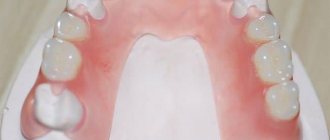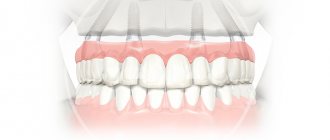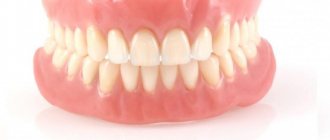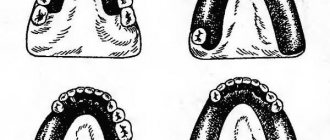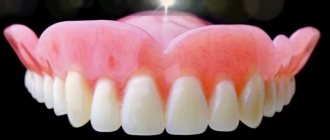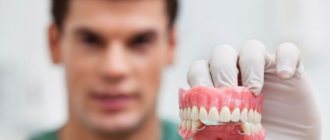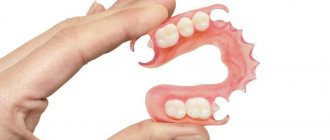Repairing a removable denture is a technical manipulation aimed at restoring its appearance, integrity and functionality. It is carried out in dental clinics or denture laboratories. According to statistics, breakage of prostheses is a common phenomenon, which is encountered by 10% of patients treated by an orthopedist. The reasons that led to this can be of various origins, and even the most expensive and high-quality products are not immune from problems. It is not always necessary to make a new prosthesis; it is quite likely that it can be repaired without incurring significant material costs.
What is a removable plate prosthesis?
A removable plate prosthesis is a base made of polymer materials into which artificial teeth are inlaid. This design is used in the absence of several or all jaw teeth, and due to the low cost and ease of manufacture, removable plastic laminar dentures are very popular among patients.
Indications
The indications for the use of removable plate dentures for teeth are very wide, since there are much fewer restrictions for this type of system than for implantation or classical dental prosthetics. In particular, these are:
- complete or partial edentia;
- impossibility of implantation or classical prosthetics (for clinical or financial reasons);
- the need to wear temporary structures before installing permanent dentures;
- allergy to metal.
Contraindications
- severe periodontal diseases;
- problems of the circulatory system;
- undergoing a course of radiation or chemotherapy;
- mental illness.
The materials for making plate dentures are usually plastic, acrylic, nylon or polyurethane. Often, it is the composition that largely influences the final cost of the design: modern plate dentures are made of hypoallergenic acrylic or nylon, which ensures comfortable wearing and almost completely eliminates allergic reactions. Based on appearance and functionality, these prostheses are divided into two types: partial laminar dentures and complete laminar dentures. Let's look at these systems in more detail.
Which doctor should I contact?
To assess the condition of the structure and help in repairing it, you need to contact the orthopedist who installed it for you. The best option is if the clinic you choose has a dental laboratory where they repair dentures, and not just create them. This will speed up the process without wasting time searching for a specialized workshop, waiting for delivery of the finished product, etc.
Restoring the integrity, function and aesthetics of artificial teeth is a job for dental technicians. Simple damage can be repaired on the same day of treatment in a few hours, especially if the clinic is equipped with its own dental laboratory. Indeed, for many patients, artificial teeth are a vital necessity, but how long the elimination of defects will take depends on the type and number of defects.
Remember that if your prosthesis is still under warranty, then in this case you absolutely need to contact the clinic where it was created for you. Intervention by third party specialists will result in loss of warranty.
If a defect appears during the warranty period, the device can be repaired free of charge by seeking help from an orthopedist who supervised the production of the system in a dental laboratory and installed it. Of course, free repairs are possible if you can come up with arguments that you followed all the doctor’s recommendations for care and operation, and the breakdowns were not your fault.
Partial plate denture
A partial removable plate denture replaces one or more lost teeth, so its shape and size directly depend on their number. To install such a prosthesis, you do not need to grind down the adjacent teeth: fixation of partial removable laminar dentures is carried out in several ways.
Types of fixation of removable laminar dentures:
Metal clasps
Hook-shaped processes starting at the base of the prosthesis and clasping the neck of the supporting tooth. Currently, they are rarely used, as they can damage tooth enamel.
Metal-free clasps
A more modern variation of conventional clasps. Made from soft, metal-free materials.
Attachmen
Small clasps that are installed on the prosthesis itself and the supporting teeth. When installing the structure, these parts are securely fixed.
Repair or complete replacement: which is cheaper and easier?
Not all patients who wear removable or fixed orthotic devices are sure whether denture repair is possible. And most, faced with such a situation, believe that this is an expensive pleasure. But devices, both with minor damage and with severe breakdowns, can be sent to a workshop if there is still a lot of time before the end of their service life and it is too early to write it off as scrap. This will be rational, especially since repairing a structure is often cheaper than ordering a new one. But, of course, there are also situations when it is easier to replace lost teeth with a new device due to the complexity of restoration, changed conditions of prosthetics (supporting teeth have fallen out, there is an allergy to the components of the materials) or when it is impossible to guarantee with certainty that it will not soon have to be repaired again due to the same reason.
REPROSTHETICS WITH ACRYLIC PROSTHETICS - RUB 150,000. instead of 180,000 rub. until January 15, 2022!
Re-prosthetics with an acrylic bridge on a metal frame (all included) up to 12 units.
Call now or request a call
Complete removable plate denture
Removable laminar dentures in the case of complete absence of teeth simulate the patient’s upper or lower jaw, so that they are significantly larger in size than removable laminar dentures in the case of partial absence of teeth. As a rule, such a design has a rather voluminous base (especially a plate prosthesis for the upper jaw), which is necessary in order to achieve a tight fit and ensure more or less stable fixation.
Methods of fixation of complete removable laminar dentures:
Clasps or attachments
Such fixation methods are used if at least a pair of healthy teeth remain on any of the jaws.
Suckers
Additional fixation elements that are usually used when a complete removable plate denture is installed on the upper jaw.
Fixation on implants
Installation of a prosthesis supported by implants. This is the most reliable, expensive and durable method of prosthetics, which is not always possible due to contraindications to implantation and the high cost of the technique.
Removable Device Recovery
Removable ones include acrylic systems, dentures with locks (attachments) without an artificial palate, clasp ones, where the base is metal arches, soft Quattro Ti, as well as thin and light Acry-Free.
The manufacture and repair of removable orthopedic appliances is one of the most popular types of dental care. Basically, their base is made of a monolith, the fracture of which can extremely rarely be repaired - only chips and broken hooks can be restored. When artificial crowns fall out, they are replaced by simply soldering them into place. When artificial enamel is chipped, it is restored using composite materials.
The situation is more complicated with clasp dentures if the metal arches that need to be soldered are damaged. Let’s look at how removable dentures are repaired and what stages the renovation may consist of using the example of reconstructing damage to a plate or acrylic denture:
- after cleaning, all parts are put together in the correct relationship to each other and fixed using adhesive wax and special holding devices,
- using a brush, an insulating substance is applied to the prosthetic bed (the back part that will face the plaster) to prevent sticking to the plaster model,
- To hold all the parts together, a backing is made from class I gypsum - a sub-cast that follows the shape of the patient's jaw. All parts connected in the first point are separated again, the broken edges are processed with cutters. The processed parts are placed on the lining, like a puzzle,
- the edges of the broken bevels are processed at an angle of 45 degrees to the base to ensure a smooth transition between the old and new plastics and their good adhesion to each other,
- a liquid insulating material is applied to the plaster so that moisture from the gypsum does not get into the new plastic,
- the parts to be glued are treated with monomer and fixed to the model,
- knead the plastic, strictly following the instructions for the ratio of components, and apply it to the joints of the disparate parts with a slight excess, after which it is polymerized in a special apparatus,
- Once the new resin has hardened, the excess material is removed and the surface of the denture is leveled, sanded and polished until smooth.
In case of other breakdowns, the steps may be different and complex devices and tools may be used. Cast metal arches - clasps - are difficult to repair. To do this, teeth and gums made of polymers are removed from the arch, and the broken metal parts are soldered together using a laser. Self-hardening adhesives are also used for acrylic devices. If there is no element in the form of an artificial tooth, then a plastic one can be built up, and a ceramic one can literally be “implanted” at high temperatures.
Nylon prostheses are glued together with special liquids, but the special technology of their manufacture often makes them unsuitable for repair. In addition, they are one of the most flexible to stretching and changing shape; even with a short period of use, they often require adjustment.
Manufacturing of plate dentures
The technology for manufacturing a plate prosthesis is considered simpler compared to the creation of most fixed structures (crowns or bridges), so the patient receives a ready-made system quite quickly (unless we are talking about installing implants).
Manufacturing stages:
- Initial consultation, examination, creation of panoramic images of the jaw and approval of the design of the prosthesis.
- Taking impressions and making a model of the patient's jaw. Determination of bite parameters.
- Making and fitting of a wax structure.
- The final stage of manufacturing a plate prosthesis, polishing the finished structure and eliminating cosmetic defects.
- Fitting and installation of the finished structure.
What is used for gluing
Reliable and durable materials are used to make dental crowns, so if you decide to glue a broken denture on your own, remember that this procedure is temporary. If such an opportunity arises, visit a specialist who will inspect the product and, if necessary, correct your errors.
Some people use regular superglue for repairs.
You can also reliably repair the product at home; you just need to follow some recommendations:
- Before starting the repair, you need to slightly warm up the structure to melt the wax, only after that you can proceed with subsequent actions. Of course, we are talking about removable structures;
- give the special plaster protrusions a conical shape. For this purpose, it is necessary to apply heat to the dentures;
- When the gluing process is completed, be sure to sand all the resulting scale with sandpaper. Then secure the crowns to the structure. Try not to mix them up;
- When all the particles are positioned correctly, glue them together using wax or other adhesive. Do not overdo it with the viscous composition;
- wait the required amount of time so that the structure can completely dry after gluing. After trying on your repaired dentures, remove any excess wax.
Denture repair process
For gluing, you can purchase glue in a specialized store, which is intended for fixing prosthetic elements. Of course, manipulations performed at home do not last forever, so if possible, entrust this task to a real master who, for a fee, will “resurrect” the structure. If you allow yourself to make any mistakes during repairs, then, most likely, such prostheses will no longer be repairable.
Glue for gluing dentures
Advantages and disadvantages
Prosthetics with plate prostheses have a number of advantages and disadvantages, which may vary depending on the type of structure. Before agreeing to have dentures installed, find out all the strengths and weaknesses of your new teeth. In addition, your attending physician should tell you about the types of plate prostheses and help you choose the best option.
- fragility (under heavy loads, a fracture of the plate prosthesis often occurs);
- short service life (up to 5 years);
- certain discomfort when wearing and difficulty getting used to (this applies to a greater extent to outdated designs);
- no load on bone tissue (except for installation supported by implants).
- ease of manufacture;
- low price. Prosthetics with removable plate dentures are considered one of the most cost-effective options for dental restoration in orthopedics;
- restoration of chewing function of teeth;
- acceptable appearance.
Features of restoration
People often mistakenly believe that denture repair is an expensive procedure. In most cases, restoration of a dental structure will not put a big dent in your wallet, although there may be situations when it will be cheaper to pay for the manufacture of new dentures than to repair old ones. It all depends on the specific case.
- Types of dentures - classification
First, it’s worth understanding what the restoration process is and what it roughly looks like. First of all, the product is thoroughly cleaned, after which, using special resins used in dentistry, the damaged parts of the structure are glued together. This allows for an optimal seal. As a result, all parts of the dentures are firmly glued together, and the structure itself is practically no different from the new one and perfectly performs its tasks.
Prosthesis repair
If a change in the color of artificial teeth is detected as a result of exposure to tobacco, wine, coffee or tea, it is necessary to clean the surface with strong substances. This procedure should be carried out by a professional so that the glossy surface of the prosthesis is not damaged as a result of cleaning. The appearance must remain perfect.
Even if the entire structure remains intact, but a small part or tooth breaks off, then you shouldn’t worry too much about this either. A qualified dental technician will be able to replace the lost part of the tooth without much difficulty or reattach it in its place if the loss has not been severely damaged.
Repaired dentures
Repairing a plate denture for teeth
Constructions of this type are considered quite fragile, especially at the point where the soft supporting part is attached to the artificial teeth. Repairing removable plate dentures is not always possible, and the degree of its success depends on the nature of the damage. In case of minor chips or breakage of clasps and attachments, restoration of removable plate dentures is often carried out, but in case of serious damage, the design usually has to be completely changed. The main reasons for the breakdown of plate dentures usually lie in careless handling (which often leads to falls of the structure) and attempts to bite through hard objects with dentures (for example, nut shells).
For what reasons do structures fail?
Among the reasons influencing the damage, there are many factors, which include errors made by the dentist and dental technician, the lack of ability to control the quality of the finished product, and patients’ non-compliance with the rules for using structures2.
Despite all the variability of causes, the basic problem is improper load distribution, which destroys the device.
Errors on the part of the doctor:
- errors in the manufacture of the base (basis),
- impurity components in the material that worsen its structure,
- initially low-quality material with low levels of flexibility and strength,
- violation of production technology (incorrectly selected temperature, the appearance of kinks in fastening points, etc.),
- non-compliance with the rules during the installation of devices, incorrect adjustment to the patient’s bite,
- physician errors in measuring occlusion and taking impressions,
- installation of dentures on initially mobile teeth,
- poorly treated abutment teeth.
The following violations are possible on the part of the patient:
- non-compliance with recommendations for the care of artificial teeth,
- exceeding the permissible load when biting and chewing foods,
- careless or incorrect daily installation (removable appliances),
- destruction and mobility of the supporting teeth on which the bridge is attached,
- jaw injury,
- falling or hitting the device on hard surfaces,
- irregular preventive examinations at the dentist, skipping doctor visits,
- use of the structure after wear and expiration of the product’s service life.
Since at first and unprofessional glance it can be difficult to determine why the prosthesis broke, this function lies with an experienced and highly qualified dentist, who, taking into account the wear of the product, the material of manufacture and the nature of the damage, will be able to reliably determine the cause and “culprit” of the breakdown. If you have such a problem, you need to see a doctor – an orthopedic dentist. But the repair will be carried out by a dental technician in the laboratory (if the damage is severe).
Restoration of the prosthesis in the clinic
The optimal restoration method will be selected after determining the degree of damage to the prosthesis through visual inspection. The examination should be performed by a qualified dental technician.
As noted earlier, cleaning must be carried out before repairing the structure. If the surface is not properly cleaned, then the adhesive used will not be able to adhere well to all parts of the prosthesis. After gluing, the specialist ensures sealing of the prosthesis in the gluing areas.
Qualified denture repair
Important! If the structure has too much damage, the patient is recommended to make new dentures instead of repair. This is done in order to save time and money.
Only if there is minor damage, the product can still be saved. In most cases, the problem lies in the loss of one or more supporting crowns. This problem can be solved by gluing new crowns into place. The resulting cracks are glued together and then sealed. The work must be carried out in such a way that the result is a solid dental structure without defects.
Repair of clasp dentures at home
If you compare self-repair with the work of a professional dental technician, then gluing a denture at home is nothing more than temporary measures. As a result, you will still have to seek help from a specialist. Only a dental technician, using the necessary materials and tools, will be able to complete this work as quickly and efficiently as possible. In addition, the patient will have the opportunity to return the original whiteness of the product, which has lost its color over the years of use. An experienced master will be able to restore the beautiful appearance of dentures without any damage.
On a note! Unfortunately, not all products can be repaired. It is impossible to repair stamped structures, as well as those prostheses that were made without the use of metal.
Not all dentures can be repaired
